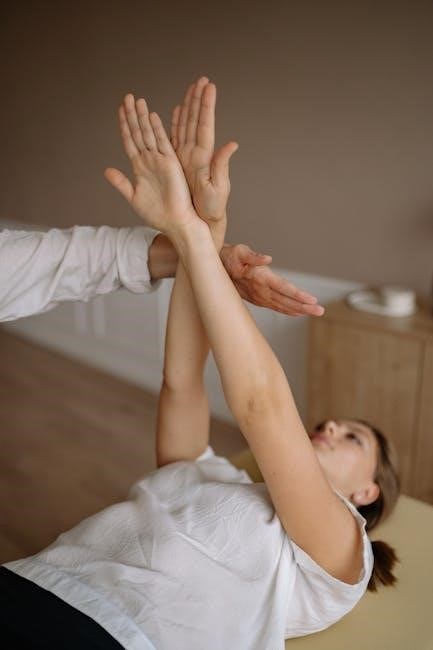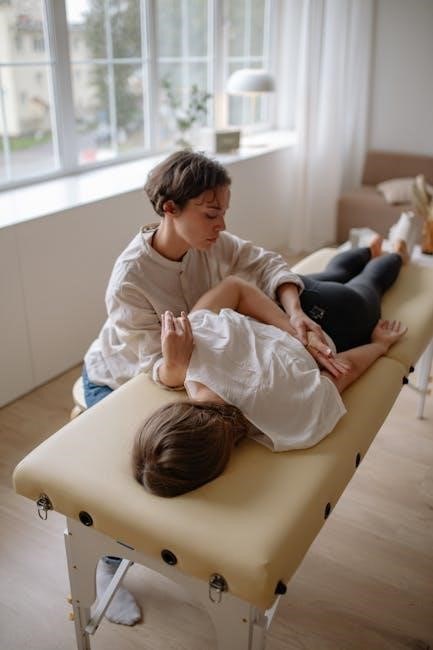and conservative approaches, to manage symptoms and improve patient outcomes effectively every day always.
Overview of Spondylolisthesis
Spondylolisthesis is a condition where a vertebra in the spine slips out of place, often causing lower back pain and discomfort; According to various studies, including a systematic review by McNeely, Torrance, and Magee, spondylolisthesis can be diagnosed across the life span of sports-participating individuals. The condition can be classified into different types, including isthmic and degenerative spondylolisthesis. A computer-assisted review of the literature suggests that determining which treatments are effective for these conditions is imperative to the rehabilitation professional. Spondylolisthesis can be caused by a variety of factors, including genetic predisposition, trauma, and wear and tear on the spine. The condition can affect anyone, but it is more common in athletes and individuals who participate in sports that involve heavy lifting, bending, or twisting. Understanding the causes and types of spondylolisthesis is essential for developing effective treatment plans and improving patient outcomes. This information is crucial for healthcare professionals, including physiotherapists, who play a vital role in managing the condition.

Causes and Symptoms of Spondylolisthesis
Causes include genetic predisposition, trauma, and wear, while symptoms are lower back pain and discomfort, with
- limited mobility
and stiffness, always affecting daily activities greatly.
Diagnosis and Treatment Options
Diagnosis of spondylolisthesis involves a combination of physical examination, medical history, and imaging tests, such as X-rays, CT scans, and MRI scans, to confirm the diagnosis and determine the severity of the condition. Treatment options vary depending on the severity of the condition and may include conservative management, such as physical therapy, bracing, and pain management, or surgical intervention, such as spinal fusion, in severe cases. A thorough evaluation by a healthcare professional is necessary to determine the best course of treatment. The goal of treatment is to alleviate symptoms, improve function, and prevent further progression of the condition. A multidisciplinary approach, including input from orthopedic specialists, physical therapists, and pain management specialists, may be necessary to develop an effective treatment plan. By working together, healthcare professionals can help patients with spondylolisthesis achieve optimal outcomes and improve their overall quality of life, with the use of various treatment methods and techniques available.
Physical Therapy Protocol for Spondylolisthesis
Physical therapy protocol involves
- exercise programs
to improve flexibility and strength, reducing pain and discomfort effectively always.
Conservative Treatment Approach
A conservative treatment approach is often recommended for patients with spondylolisthesis, involving a combination of non-surgical methods to manage symptoms and improve function. This approach typically includes physical therapy, with a focus on exercise and education to promote proper posture, reduce pain, and improve mobility. According to recent studies, a computer-assisted diagnosis can help determine the most effective treatment plan. Additionally, treatment options may include the use of nonsteroidal anti-inflammatory drugs, heat, and light exercise to reduce pain and inflammation. A systematic review of physiotherapy for spondylolysis and spondylolisthesis found that conservative treatment approaches can be effective in managing symptoms and improving patient outcomes. Overall, a conservative treatment approach can be a viable option for patients with spondylolisthesis, and can help to reduce the need for surgical intervention. With proper treatment and care, patients can experience significant improvements in their quality of life.
Exercise Therapy for Spondylolisthesis
Exercise therapy involves
- specific exercises
to improve posture and reduce pain effectively always using a p tag.
Rehabilitation Program for Cricket Athletes
A rehabilitation program for cricket athletes with spondylolisthesis involves a structured approach to managing symptoms and improving function. This includes a combination of exercise therapy, physical therapy, and education on proper techniques to reduce the risk of injury. According to Sami Bounaouara, Dave Fone, and Sam Mellor from the University of Nottingham, exercise therapy is an essential component of rehabilitation for cricket athletes with spondylolisthesis. The program should be tailored to the individual athlete’s needs and goals, taking into account their specific position and demands of the sport. A comprehensive rehabilitation program can help cricket athletes with spondylolisthesis return to play safely and effectively, reducing the risk of further injury and improving overall performance. The program should be designed and implemented by a qualified healthcare professional, such as a physical therapist or athletic trainer, with expertise in sports medicine and rehabilitation. Regular progress monitoring and adjustments to the program are necessary to ensure optimal outcomes.
Use of Oswestry Disability Index in Treatment
Oswestry Disability Index measures functional disability, guiding treatment decisions effectively always with physical therapy protocols.
Nonsteroidal Anti-Inflammatory Drugs and Heat Therapy
Nonsteroidal anti-inflammatory drugs and heat therapy are commonly used to manage pain and inflammation in patients with spondylolisthesis. These treatments can be used in conjunction with physical therapy to help improve patient outcomes. The use of nonsteroidal anti-inflammatory drugs can help reduce pain and inflammation, while heat therapy can help relax muscles and improve mobility. A physical therapist may recommend the use of heat therapy, such as a warm bath or shower, or the use of a heating pad to help relieve pain and stiffness. Additionally, nonsteroidal anti-inflammatory drugs may be prescribed by a doctor to help manage pain and inflammation. It is essential to follow the recommended treatment plan and to consult with a healthcare professional before starting any new treatments. By combining nonsteroidal anti-inflammatory drugs and heat therapy with physical therapy, patients with spondylolisthesis can experience significant improvements in their symptoms and quality of life. This approach can help patients return to their normal activities and improve their overall well-being.

Importance of Bed Rest and Bracing in Treatment
Bed rest and bracing are essential components of treatment, helping to reduce pain and stabilize the spine, allowing for proper healing and rehabilitation to occur effectively every day.
Role of Traction in Spondylolisthesis Treatment
Traction is a treatment method used to relieve pain and pressure on the spine, it involves the use of a traction device to gently stretch and separate the vertebrae. The goal of traction is to reduce the pressure on the affected discs and nerves, allowing for healing and reducing inflammation. Traction can be performed manually or with the use of a machine, and it is often used in conjunction with other treatments such as exercise and bracing. According to recent studies, traction has been shown to be effective in reducing pain and improving function in patients with spondylolisthesis. A study published in the Journal of Manual Therapy found that traction was effective in reducing pain and improving range of motion in patients with spondylolisthesis. The use of traction in spondylolisthesis treatment is a common practice, and it is often recommended by physical therapists and other healthcare professionals. Traction is a non-invasive and non-surgical treatment option, making it a popular choice for patients who are looking for alternative treatments. Overall, traction plays an important role in the treatment of spondylolisthesis, and it is often used as part of a comprehensive treatment plan.

